Toyota RAV4 (XA40) 2013-2018 Service Manual: Brake front brake flexible hose
Components
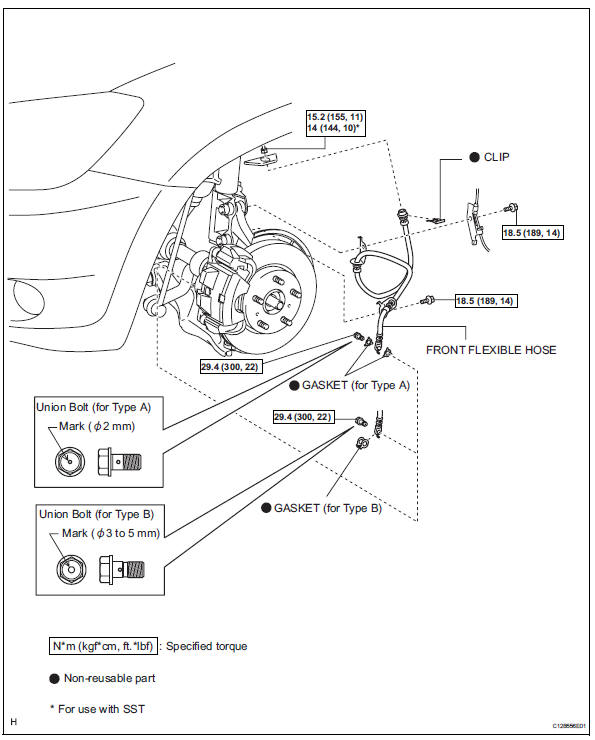
Removal
Hint:
- Use the same procedures for the lh side and rh side.
- The procedures listed below are for the lh side.
- Remove front wheel
- Drain brake fluid
Notice:
Wash off brake fluid immediately if it comes in contact with any painted surface.
- Remove front flexible hose
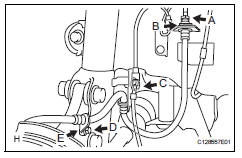
- Disconnect the brake tube (labeled a) from the flexible hose with sst while holding the flexible hose with a wrench.
Sst 09023-00101
Notice:
- Do not bend or damage the brake tube.
- Do not allow any foreign matter such as dirt and dust to enter the brake tube from the connecting point.
- Remove the clip (labeled b).
- Remove the 2 bolts (labeled c, d) and then remove the flexible hose clamp (labeled e) from the knuckle.
- Remove the sensor clamp and flexible hose clamp from the flexible hose bracket.
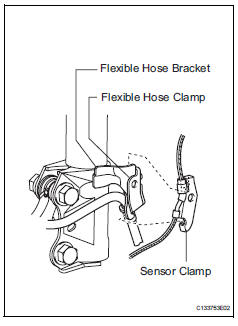
- Remove the union bolt and gasket(s), and then remove the flexible hose from the disc brake cylinder.
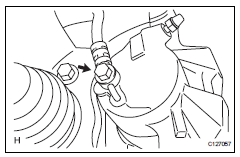
Installation
Hint:
- Use the same procedures for the lh side and rh side.
- The procedures listed below are for the lh side.
- Install disc brake cylinder assembly lh
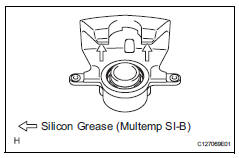
- Apply silicon grease (multemp si-b) on the contact surfaces of the cylinder parts indicated by the arrows.
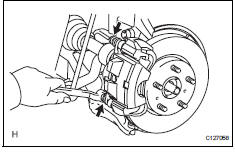
- Install the cylinder with the 2 bolts.
Torque: 34.3 N*m (350 kgf*cm, 25 ft.*Lbf)
- Connect front flexible hose
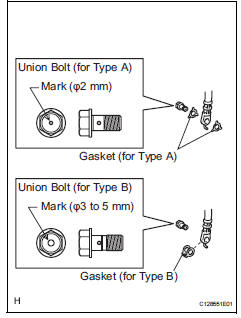
Notice:
The gasket and union bolt must be used as a set, as shown in the illustration.
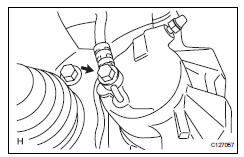
- Connect the flexible hose with new gasket(s) and the union bolt.
Torque: 29.4 N*m (300 kgf*cm, 22 ft.*Lbf)
Hint:
Install the flexible hose lock securely in the lock hole in the cylinder.
- Fill reservoir with brake fluid (see page br- 6)
- Bleed air from brake master cylinder (see page br-7)
- Bleed air from brake line (see page br-7)
- Bleed air from abs and traction actuator assembly (see page br-8)
- Check brake fluid level in reservoir (see page br-6)
- Check for brake fluid leakage
- Install front wheel torque: 103 n*m (1,050 kgf*cm, 76 ft.*Lbf)
Installation
Hint:
- Use the same procedures for the lh side and rh side.
- The procedures listed below are for the lh side.
- Install front flexible hose
Notice:
- The flexible hose has an identification color. Make
sure of the identification color when installing the
flexible hose.

- The gasket and union bolt must be used as a set, as shown in the illustration.
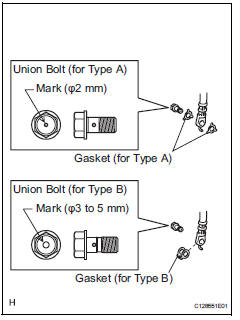
- Connect the flexible hose with new gasket(s) and the union bolt to the disc brake cylinder.
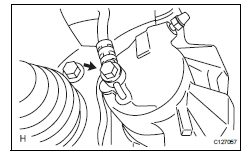
Torque: 29.4 N*m (300 kgf*cm, 22 ft.*Lbf)
Hint:
Install the flexible hose lock securely in the lock hole in the cylinder.
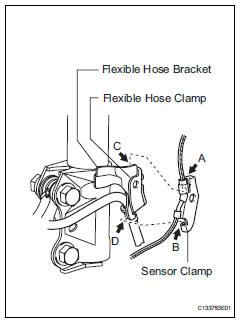
- Set the flexible hose clamp on the flexible hose bracket.
- Simultaneously perform the following: 1) hang the hook part of the sensor clamp (labeled a) on the flexible hose bracket (labeled c); and 2) insert the hook part of the sensor clamp (labeled b) into the flexible hose bracket (labeled d).
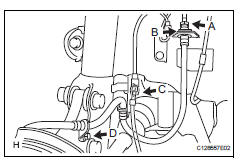
- Tighten the bolt (labeled c) to fix the flexible hose
clamp and sensor clamp.
Torque: 18.5 N*m (189 kgf*cm, 14 ft.*Lbf)
- Install the flexible hose with the bolt (labeled d).
Torque: 18.5 N*m (189 kgf*cm, 14 ft.*Lbf)
- Set the flexible hose to the connecting point with the brake tube (labeled a), and then attach a new clip (labeled b).
- Using sst, connect the flexible hose to the brake tube (labeled a) while holding the flexible hose with a wrench.
Sst 09023-00101
Torque: 15.2 N*m (155 kgf*cm, 11 ft.*Lbf) without sst
14 N*m (144 kgf*cm, 10 ft.*Lbf) with sst
Hint:
Use a torque wrench with a fulcrum length of 30 cm (11.81 In.).
Notice:
- Do not bend or damage the brake tube.
- Do not allow any foreign matter such as dirt and dust to enter the brake tube from the connecting point.
- Fill reservoir with brake fluid (see page br- 6)
- Bleed air from brake master cylinder (see page br-7)
- Bleed air from brake line (see page br-7)
- Bleed air from abs and traction actuator assembly (see page br-8)
- Check brake fluid level in reservoir (see page br-6)
- Check for brake fluid leakage
- Install front wheel torque: 103 n*m (1,050 kgf*cm, 76 ft.*Lbf)
 Front brake
Front brake
Components
Removal
Hint:
Use the same procedures for the lh side and rh side.
The procedures listed below are for the lh side.
Remove front wheel
Drain brake fluid
Notic ...
 Rear brake
Rear brake
Components
Removal
Hint:
Use the same procedures for the lh side and rh side.
The procedures listed below are for the lh side.
Remove rear wheel
Drain brake fluid
Notice:
W ...
Other materials:
Wireless remote control/electronic key battery
Replace the battery with a
new one if it is depleted.
â– If the key battery is depleted
The following symptoms may occur:
The smart key system (if
equipped) and wireless remote
control will not function properly.
The operational range will be
reduced.
Items to prepare
Prepare the following be ...
Side doors
Unlocking and locking the doors
The vehicle can be locked and unlocked using the key, entry function,
wireless remote control or door lock switch.
Entry function (if equipped)
Wireless remote control
Key
Vehicles without a smart key system
Locks all the doors
Unlocks all the doors
Tur ...
If the vehicle is submerged
or water on the road is rising
This vehicle is not designed
to be able to drive on roads
that are deeply flooded with
water. Do not drive on roads
where the roads may be
submerged or the water
may be rising. It is dangerous
to remain in the vehicle,
if it is anticipated that the
vehicle will be flooded or
set adrift. Remain calm ...
